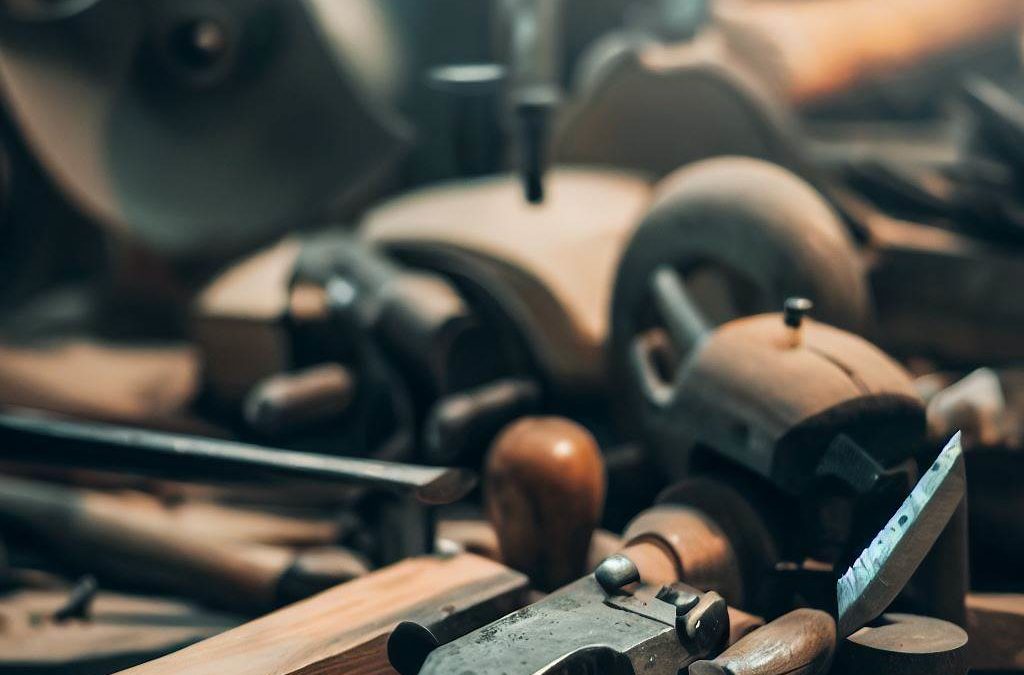Welcome to the exciting world of woodworking, where a blend of creativity and practical skills come together to create functional and beautiful pieces. Whether you’re an experienced woodworker or just starting out, having the right tools in your workshop can make all the difference in achieving successful results.
In this blog post, we’ll explore various hand and power tools used in a woodworking shop, along with essential stationary tools and specialized equipment to take your craftsmanship to new heights.
Hand And Power Tools For Woodworking
Chisels are essential hand tools used to carve and shape wood, while hand planes help smooth out rough surfaces.
Chisels
Chisels are a fundamental woodworking hand tool that every woodworker should have in their shop. These versatile tools consist of a sharp, beveled edge attached to a wooden or plastic handle and are used for tasks such as carving, shaping, and cutting various types of wood.
There is an array of chisel types available on the market, each designed for specific woodworking tasks. For example, bench chisels are perfect for general-purpose work while dovetail chisels offer precise control when creating delicate joints in cabinetry or furniture-making projects.
Mortise chisels help create intricate mortise-and-tenon joints commonly found in traditional timber frame structures.
Hand Planes
Hand planes are essential woodworking tools that have been in use for centuries. They are used to smooth, shape, and level surfaces of wood by removing thin shavings.
A hand plane consists of a blade or iron which is fixed at an angle to a wooden base known as the body, and a knob or handle at the front to control it.
A popular type of hand plane is the smoothing plane which is used to create a highly polished finish on wood surfaces. Smoothing planes typically have blades with shallow angles and narrow throats for precision cutting.
They can also be used on curved or angled surfaces by tilting the blade slightly during use. Other common types of hand planes include jack planes and shoulder planes, both useful for rough shaping and trimming edges respectively.
Handsaws
Handsaws are essential in a woodworking shop and come in various styles for different cutting tasks. The most common handsaw is the crosscut saw, used for cutting across the grain of wood.
Additionally, rip saws cut with the grain while panel saws are ideal for precision cuts on thin materials. A coping saw is perfect for intricate work and curved cuts while a dovetail saw is great for joinery.
Investing in quality handsaws can make all the difference with time efficiency and accuracy when working on projects that require hand-cutting techniques.

Clamps
Clamps are a crucial part of any woodworking shop. They hold pieces in place during the cutting, sanding, and joining processes. There are various types of clamps available for different tasks, including bar clamps, pipe clamps, F-style clamps and quick-grip clamps.
Bar clamps are versatile and can be adjusted to fit the size of the workpiece. Pipe clamps operate on the same principle but use pipes as their bars instead; they can cover a more extensive range than bar clams but aren’t adjustable.
F-style Clam uses two jaws connected by a bar with an adjustable screw that can exert high pressure across joints parallel faces; they’re perfect for cabinetmaking and frame assembly.
Quick-grip or one-handed-clams is best for DIYers as it allows single-handed operation when holding smaller projects together temporarily, while other accessories clamp securely onto them when working with larger parts.
Table Saw
The table saw is one of the most essential and versatile tools in any woodworking shop. This powerful machine consists of a circular blade mounted on an electric motor that rotates at high speeds to cut through wood with precision and speed.
Table saws come in various sizes and configurations, from small benchtop models to large cabinet-style saws that can handle even the biggest projects.
To use a table saw effectively, it’s important to have the proper accessories such as a miter gauge, fence, push stick, and blade guard. Safety is also crucial when working with this tool since it involves spinning blades that can cause serious injuries if not handled correctly.
Router
A router is a powerful woodworking tool that can perform a wide variety of tasks. It is used to hollow out or profile an area in wood and make decorative cuts and shapes.
A good router should have variable speed settings, allowing you to control the RPMs for different types of cuts. It’s important to use the correct bit with your router, depending on the task at hand.
For example, if you’re edging a piece of wood, you would want to use an edge-forming bit. On the other hand, if you’re cutting a groove into your wood project, you’ll need a straight or spiral bit.
Drill Press
A drill press is one of the most versatile tools in a woodworking shop. It’s a stationary tool that can drill holes with greater accuracy and precision than handheld drills.
Drill presses are available in several sizes, but the most common ones have a spindle range of 500 to 3000 RPMs with adjustable speed settings. The advantage of having a drill press is that it can create perfectly straight and angled holes when using an angled drilling table attached.
When using a drill press, safety should be given top priority because they have sharp rotating bits that could cause severe injuries if not handled correctly.
Jointer
A jointer is a woodworking tool used to create perfectly flat and straight edges on wood boards. It’s an essential tool for creating smooth, flush joints between two pieces of wood.
The jointer works by using rotating knives to shave off thin layers of wood from the board’s surface until it becomes perfectly flat. This machine is particularly useful when working with rough sawn lumber or twisted boards that are difficult to work with otherwise.
Investing in a high-quality jointer can make all the difference for your woodworking projects, ensuring that you achieve precise cuts and perfect seams every time.
Measuring And Layout Tools
Measuring and layout tools are crucial for precise woodworking. These include tape measures, rulers, squares, levels, and angle finders. Tape measures are essential for measuring longer distances while rulers are best suited for shorter measurements.
Squares come in various sizes and shapes to ensure that your angles remain accurate throughout the project.
One popular tool is a digital caliper – this allows you to accurately measure the thickness of wood or the diameter of dowels or screws quickly and efficiently. A flat surface like a workbench is also necessary when taking these measurements as it provides stability when using measuring equipment such as a spirit level or straight-edge ruler.

Essential Stationary Tools For Woodworking
The essential stationary tools for woodworking include a planer, lathe, belt sander, and disc sander.
Planer
A planer is an essential stationary tool for woodworking that flattens and smooths wooden boards. It’s a must-have if you want to ensure your project comes out with clean, straight edges.
The machine comprises two parallel blades that rotate in opposite directions, cutting away thin slices of wood from the surface of the board. A planer can also be used to adjust thickness, making it perfect for creating uniform boards or leveling joints.
Although some carpentry purists consider hand planes superior to power planers for certain tasks, most modern woodworkers prefer using power tools like electric handheld planers or benchtop models for convenience and speed.
There are several types of Planers on the market today – portable thickness planers, stationary thickness planers, and jointer-planer combination machines which incorporate a jointing feature into their design, making them more versatile than single-purpose machines altogether – all these make Planers one of the most important tools found in any woodworking shop arsenal alongside other key equipment such as Table saws, drills presses and sanding accessories.
Lathe
The lathe is an essential stationary tool for any serious woodworking shop. It allows you to shape and turn wood into various forms, from intricate spindles to decorative bowls.
A lathe consists of a bed, headstock, tailstock, and tool rest that work together to create precise cuts on the wood. There are different types of lathes that vary in size and capabilities, from small benchtop models suitable for hobbyists to large industrial-sized machines used by professionals.
Belt Sander
A belt sander is a must-have tool in any woodworking shop. It’s versatile and can be used for various tasks such as smoothing rough surfaces, shaping curves, and removing old finishes.
One advantage of using a belt sander is that it allows you to remove material from your workpiece much more quickly than with traditional hand tools. Plus, you can switch out belts of different grits depending on what stage of the project you’re in – coarse grits for heavy stock removal and finer grits for finishing touches.
Disc Sander
A disc sander is a stationary tool used for sanding and smoothing large, flat surfaces. It consists of a circular sanding disc that rotates on a motorized spindle and can be adjusted to various angles for versatility in use.
When using a disc sander, it’s important to wear protective gear like safety glasses and earplugs as the machine can produce significant noise and debris. The operator should also avoid overloading the sander with too much pressure or material at once as this can cause damage to both the sandpaper and the machine itself.
Specialized Woodworking Tools
Specialized woodworking tools like the band saw, scroll saw, mortiser, and miter saw are critical for precision cutting and joinery.
Band Saw
When it comes to specialized woodworking tools, a band saw is an essential piece of equipment that can make intricate cuts and shapes with ease. This stationary power tool uses a continuous looped blade mounted on two wheels to create smooth, accurate cuts in wood.
A popular use of the band saw is resawing – cutting thicker pieces of wood into thinner slices – which allows woodworkers to create book-matching veneers or achieve consistent thicknesses for specific projects.
The versatile nature of the band saw also means that it can handle a variety of materials like metal or plastic with different types of blades available.
Scroll Saw
A scroll saw is a specialized tool used in woodworking that allows for intricate and detailed cuts to be made in a variety of materials.
It consists of a thin blade that moves up and down rapidly, allowing the user to create precise designs with ease. Scrolls saws are often used by hobbyists who enjoy creating decorative pieces such as puzzles or ornate picture frames.
One unique feature of scroll saws is their ability to make inside cuts, meaning that the blade can cut out shapes from within a larger piece of material without having to enter through an edge.
This creates endless possibilities for creative designs and allows woodworkers greater flexibility when it comes to their projects.
Mortiser
A mortiser is a specialized tool used in woodworking to create rectangular, square or round holes known as mortises. This tool is particularly useful when creating joints between two pieces of wood that require a tight fit.
Mortises are often required for the creation of furniture and can be made using various types of machines, including benchtop models or floor-standing versions.
One popular type of mortising machine is the hollow chisel mortiser which uses a drill bit with an attached chisel to remove material from within the hole being created. Other variations include horizontal and vertical slot mortises which use rotating cutter heads to cut out the desired shape.
Miter Saw
A miter saw is an essential tool in any woodworking shop. It’s perfect for making angled cuts on wood, which is crucial when you’re working on projects that require precision and accuracy.
The blade of a miter saw is mounted on a pivoting arm, allowing you to adjust it to the desired angle or bevel before making your cut.
One of the main advantages of using a miter saw is its ease of use and versatility. Whether you’re cutting trim work, molding, or framing lumber for a project, this tool makes quick and accurate work of it all.
Some models come with additional features such as laser guides or digital displays, making them even more user-friendly.

Safety Gear And Precautions In A Woodworking Shop
To ensure safety in a woodworking shop, it is essential to wear protective gear such as eye and ear protection, dust mask, apron, gloves, and safety glasses while working with equipment.
Additionally, fire safety should not be overlooked; proper ventilation and lighting should be in place to prevent accidents.
Eye And Ear Protection
Eye and ear protection are two crucial safety precautions that no woodworker should overlook. When working with power tools or machinery, flying debris can easily cause eye injuries if proper protective eyewear is not worn.
Similarly, loud noises from woodworking equipment can cause hearing loss over time if ear protection is neglected. Earplugs or earmuffs can be used to reduce exposure to high noise levels when operating loud machinery.
Dust Mask
Woodworking produces a lot of dust, which can be harmful to your lungs if inhaled. That’s why it’s important to wear a dust mask while working with wood.
A good-quality dust mask should have a rating from the National Institute for Occupational Safety and Health (NIOSH). Dust masks come in various types, including paper masks and respirators.
If you’re working with particularly toxic substances or producing large amounts of sawdust, consider investing in a respirator that can filter out finer particles.
Apron
An apron is a must-have safety gear in any woodworking shop. It protects your clothes and skin from sawdust, flying debris, and spilled chemicals while keeping you comfortable during long hours of work.
A good woodworking apron should cover the front of your body and wrap around your sides for maximum protection. Some aprons come with adjustable neck straps and waist belts to ensure a snug fit, while others have multiple pockets for storing tools or holding screws and nails.
They are available in different materials such as leather, canvas or denim depending on the amount of wear and tear they will endure.
Gloves
Gloves are an essential safety gear item in any woodworking shop. They provide protection for your hands from cuts, splinters, and sharp tools. However, it’s important to choose the right type of gloves for the job.
For example, when handling rough lumber or using a table saw, sturdy work gloves can help prevent splinters and minor injuries. On the other hand, when working with delicate finishing materials like varnish or stains, latex gloves or nitrile exam gloves may be more appropriate to avoid contamination and preserve a smooth surface finish.
Safety Glasses
Safety glasses are an essential piece of safety gear in any woodworking shop. They protect your eyes from flying wood chips, sawdust, and other debris that may cause eye injuries.
Safety glasses come in a variety of styles and can be fitted with prescription lenses for those who wear glasses daily.
It’s important to note that not all safety glasses are created equal; some have higher impact resistance than others, so you should choose the appropriate ones for your type of work.
Additionally, it’s crucial to ensure a proper fit to avoid gaps where debris can enter.
Hearing Protection
The noise level in a woodworking shop can be deafeningly loud, especially when working with power tools like table saws and routers. Constant exposure to loud noise can damage your hearing over time, so it’s crucial to protect your ears while you work.
Hearing protection comes in different forms, including earplugs and earmuffs. Foam earplugs are cheap and effective at blocking out sound waves, but they can be uncomfortable after prolonged use.
These days, some earmuffs come equipped with Bluetooth connectivity that allows you to listen to music or take phone calls without taking off the earmuffs. However, keep in mind that safety should always come first; if your job requires concentration or poses danger to yourself or others around you – like operating machinery – then avoid using them for this purpose as it might lead to an unsafe environment.
Fire Safety
Fire safety is an essential aspect to consider in any woodworking shop. Wood dust and shavings can easily ignite if they come into contact with hot tools or sparks. First and foremost, it is important to have fire extinguishers strategically placed throughout the workshop in case of a fire emergency.
In addition, it’s crucial to ensure that all electrical wiring and outlets are up to code and not overloaded. Keeping the work area clean by regularly sweeping up wood debris can also help prevent fires.
Investing in high-quality smoke detectors and having them installed in different areas of the shop can provide an added layer of protection against potential fires.
Finally, make sure that flammable liquids such as paint thinners or solvents are stored away from heat sources and used only when necessary with proper precautionary measures taken beforehand.
Proper Ventilation And Lighting
Proper ventilation and lighting are crucial aspects of any woodworking shop. Adequate ventilation helps to minimize the risks associated with inhaling dust, fumes, and other harmful substances that may be released during the woodworking process.
This can be achieved through a combination of exhaust fans, air filtration systems, and regular cleaning. Good lighting is also essential for both safety and productivity in your workshop.
In addition to helping you stay safe while working with power tools, proper ventilation and lighting can also improve the quality of your finished projects.
Without good airflow, sawdust and other debris can settle onto surfaces causing blemishes on unfinished wood or paint jobs. Insufficient light can lead to missed cuts or mishaps when using blades or hand tools.
Emergency Preparedness
It’s important to always be prepared for emergencies in a woodworking shop. This includes having a hand first aid kit with bandages, antiseptic wipes, gauze, and adhesive tape.
A fire extinguisher should also be easily accessible in case of any fires that may occur from sparks or electrical malfunctions. It’s also smart to have an emergency plan in place with clear exit routes and designated meeting places outside the workshop.
Regular safety drills can help ensure everyone knows what to do in case of an emergency. In addition, it’s a good idea to keep a phone readily available in case of severe accidents or incidents requiring immediate medical attention.
So Much Information!
Woodworking is an art that requires dedication and the right tools to create beautiful pieces. This blog has discussed the various hand and power tools used in a woodworking shop.
From chisels to table saws, each tool has its own purpose in creating stunning designs.
However, safety should always be a top priority when working with any of these tools.
Remember that proper ventilation and lighting also play a crucial role in keeping you safe from accidents or injuries at all times.
